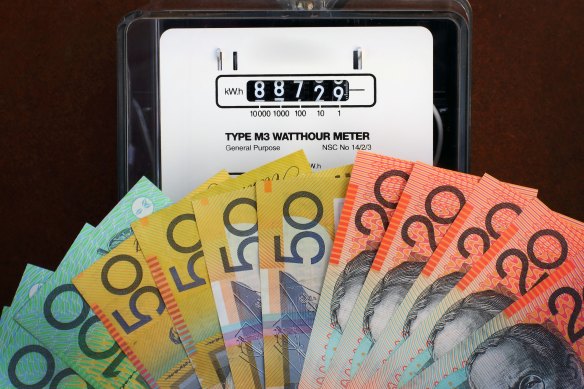Save articles for later
Add articles to your saved list and come back to them any time.
Cost of living pressures are returning as a key issue for the Albanese government following the Voice referendum, as rising petrol prices drive up inflation and advocacy groups warn that another round of power bill relief is needed before the end of the year as high energy prices squeeze households budgets.
Global conflict is driving the cost of energy. Federal Treasury said the weaker Australian dollar coupled with a cut in supply by oil-producing nations and the war in Ukraine had combined to drive up petrol prices 7 per cent, which in turn were expected to add a quarter of a percentage point to inflation over the three months to September.
Power bills are set to remain high for years to come.Credit: iStock
The government promised during the 2022 election to lower power bills by $275 but since then prices have soared, largely because the cost of energy was driven up thanks to a global market crunch caused by Russia’s invasion of Ukraine in February 2022.
These increases to input costs flowed through this year to default contracts that electricity retailers locked in for 12 months at the start of the financial year, when annual bills rose $352 in Victoria at the start of July and $435 in NSW.
St Vincent De Paul general manager of policy and research Gavin Dufty said more bill relief for vulnerable households was needed by the end of the year.
“We are actively encouraging governments to do some more support for households, particularly in the energy space before Christmas or shortly thereafter because that is where there’s a significant bill load on households.”
The Albanese government responded to rising power bills by slapping caps on the price of coal and gas sold into the Australian market in December last year. The Australian Energy Market Regulator said, in its quarterly report released on Monday, that the price caps helped lower the cost of energy generation with “significant increases in the volume and proportion of output offered at lower price ranges by black coal-fired generators”.
Treasury expects the current conflict in the Middle East will impact future global oil and fuel prices, and Treasurer Jim Chalmers said consumer price pain was top of his government’s agenda.
“Higher petrol prices and the costs of other essentials are putting Australians under the pump and that’s why our government’s primary focus is to address inflation and the cost of living,” Chalmers said.
The 7 per cent petrol price jump over the three months to September is the largest quarterly rise since prices spiked 11 per cent in the March quarter last year, after Russia invaded Ukraine.
A spokesperson for Climate Change and Energy Minister Chris Bowen said government rebates had largely offset power price rises for most eligible households, and lowered the bills payable for the most financially vulnerable by 18 per cent.
“For those households receiving energy rebates, bill increases in most jurisdictions have been completely offset and in fact have decreased by up to 18 per cent for the most vulnerable Australians,” Bowen said.
The government also delivered a package of subsidies in the federal budget in May, which offered rebates worth $500 to 5 million financially vulnerable households and small businesses. The Victorian government chipped in with rebates worth $250 and NSW $180.
However, Dufty said food prices were up by around 10 per cent, mortgage repayments have risen sharply and the cost of petrol is above $2 a litre, factors which are compounding the financial pressure on households heading into the expensive festive season.
“Christmas is crunch time particularly for families because you’ve got kids at home for six to eight weeks, social obligations on households to entertain and buy gifts and it is quite expensive,” he said.
A recent Australian Council of Social Service survey of 427 people receiving income support showed that almost all (97 per cent) are taking some action to cut back on their energy use to lower their bills, including 74 per cent cutting back on cooling and heating and 62 per cent cutting back lighting.
Chief executive of advocacy group for residential and small business power customers Energy Consumers Australia, Brendan French, said despite the previous round of bill relief, more was needed soon.
“The winter rebates and other supports have been a relief for some, but rising energy bills and rising cost of living mean a broader range of people are experiencing financial stress and need help,” French said.
“Households below median household income spend between 3 per cent and 12 per cent of their income on energy bills, compared with those on the highest incomes, who pay around 1.5 per cent.”
Coalition Climate Change and Energy Spokesman Ted O’Brien said the opposition would be constructive in working with the government to address cost of living issues, but claimed its renewable energy policy was contributing to rising power bills.
“There’s a tragic human cost to Labor’s flawed energy policies and what worries me most is that it’ll get worse unless the government reverses its policy direction,” O’Brien said.
The Morning Edition newsletter is our guide to the day’s most important and interesting stories, analysis and insights. Sign up here.
Most Viewed in Politics
From our partners
Source: Read Full Article




